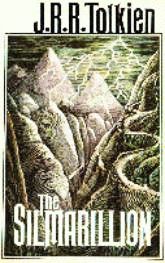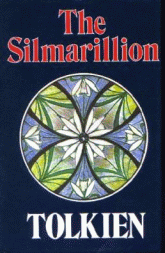After finishing up MultiReal (for the time being, at any rate), I felt that I needed to immerse myself in something familiar. Something classic. And so I decided to re-read J.R.R. Tolkien’s books on Middle Earth chronologically from start to finish, from The Silmarillion to Return of the King with a pitstop at the newly published Children of Húrin.
This will probably be my fourth round trip through the whole cycle, the first being sometime around 1978 and the last coming somewhere around 1996. So as I go back and revisit Middle Earth, I’m going to blog about my impressions here. I assume just about everybody in creation has either read the series or seen the Peter Jackson films by now, so I won’t worry about spoilers.
*****
 I’m always struck by people who claim to love The Lord of the Rings but find The Silmarillion impossible to read. In the same vein, I wonder exactly why LOTR readers from the ’60s and ’70s went so gaga over it.
I’m always struck by people who claim to love The Lord of the Rings but find The Silmarillion impossible to read. In the same vein, I wonder exactly why LOTR readers from the ’60s and ’70s went so gaga over it.
To me, The Silmarillion is what the whole thing is about. The Silmarillion is the cake of Tolkien’s work, while The Lord of the Rings is largely the frosting. (Which might leave The Hobbit as that gooey ribbon of fudge that runs through the middle.) Now there’s nothing wrong with indulging in a nice big dollop of frosting — I’m a sucker for that salty-sweet stuff they put on cheap grocery store cakes — but it’s more satisfying when you’ve got something to anchor it.
So if you’ve read The Lord of the Rings and you haven’t read The Silmarillion — or at least spent long hours studying the appendices in Return of the King — then you’re missing the Big Picture. You don’t really know what Tolkien was up to. You’ve got a great adventure story with some fabulous characters and a peerless amount of detail around the edges, but that’s about it. For many people, that’s enough.
So what was Tolkien up to? Once you see the entire tapestry laid out, you realize that J.R.R. Tolkien was writing one of the world’s great parables about mankind’s Fall from Grace.
The main thread of The Silmarillion chronicles the rebellion of the Elf Fëanor against the Valar, the gods who are his shepherds, teachers, and protectors. Both are faced with the treachery of the evil Morgoth, who mars the world the Valar built and steals the Silmaril jewels Fëanor created. The Valar choose to fence themselves inside their land of Valinor and leave Morgoth to his own devices; Fëanor, on the other hand, refuses to accept compromise. He announces he’s going to leave Valinor and do whatever it takes to recover the Silmarils. And in doing so, of course, he overreaches and drags his whole people down with him over the next thousand years.
Call it blasphemy, but to me, Tolkien distilled the essence of the Fall from Grace much better than the actual Bible does. I find the Old Testament frequently hokey and morally confused, while Tolkien’s achievement in metaphor is a beautiful, transcendent, and clear as a bell. (Keep in mind, of course, that I’m an atheist.) The story of Adam and Eve’s exile from the Garden of Eden strikes me as ludicrous and almost laughable; but when I read about Fëanor’s exile from Valinor in The Silmarillion, I get it.
The Bible uses all kinds of metaphors for Heaven. It’s a pasture, it’s a garden, it’s a place in the clouds, it’s a kingdom full of light. All metaphors that must have been really impressive to the nomadic desert-bound Jews who first heard them. But for us, these images don’t have so much potency. Paradise is a garden? Dude, if I want to see a transcendently beautiful garden, I can drive to Delaware and see Longwood Gardens.
But Tolkien? Tolkien writes about the great lamps of Illuin and Ormal that the Valar built to light the world, which Morgoth overthrew — and then about the trees Telperion and Laurelin grown by the Valar to replace those lamps, and how Morgoth poisoned those — and about the second-rate tree Galathilion the Vala Yavanna made to remind the Elves of those original trees — and the seedling of that tree named Celeborn, which was planted on the Elvish island of Tol Eressëa — and then the seedling of that tree, Nimloth, that the Elves gave to the Men of Númenor — and then the fruit of that tree that Isildur managed to smuggle out of Númenor before its destruction — and then the sapling of that tree Isildur smuggled out of Minas Ithil when Sauron destroyed it — and then the sapling of that tree planted by the twenty-seventh king of Gondor, until it died — and finally the sapling of that tree which Aragorn finds in The Return of the King.
Now that’s a Fall from Grace. That’s a metaphor for the spark of God’s majesty continuing on despite adversity and debasement which I can understand.
 But similarly, Tolkien puts this divine spark inside of us, too, the readers. We’re (theoretically) remote descendants of the people of Gondor, who were descended from the people of Númenor, who were descended from the Edain that helped out the Elves in their battles against Morgoth. And we’ve also got in our blood strains of the Elves (through the marriage of Beren and Lúthien) and strains of the gods (through the marriage of Thingol and Melian the Maia). It’s remote, it’s diluted, but it’s there in all of us.
But similarly, Tolkien puts this divine spark inside of us, too, the readers. We’re (theoretically) remote descendants of the people of Gondor, who were descended from the people of Númenor, who were descended from the Edain that helped out the Elves in their battles against Morgoth. And we’ve also got in our blood strains of the Elves (through the marriage of Beren and Lúthien) and strains of the gods (through the marriage of Thingol and Melian the Maia). It’s remote, it’s diluted, but it’s there in all of us.
This presumes, of course, that you are of white European descent. Which leads to one of the most controversial — and least understood — elements of Tolkien’s world. If you’re not a white European, according to Tolkien’s mythology, you’re descended from one of the wicked tribes of men who fell under the sway of the evil god Morgoth.
Racist? Sure. But it’s only right that Tolkien should put things that way, and I’m glad Peter Jackson didn’t try to appease these cries of racial insensitivity in his films by casting a bunch of polychromatic hobbits. Why? Not because I believe in that kind of white-is-right bullshit — but simply because Tolkien’s other major purpose in writing these stories was to create an alternate Anglo Saxon mythology.
These are the tales that the Anglo Saxon warriors told around the fire after everyone got sick of hearing Beowulf for the five hundredth time. And when you’re tired from a day in the field hacking away at people that don’t look like you, the last thing you want to hear is how these enemies are just misunderstood souls with their own culture, history, and moral compass. You want to be reminded that you’re a true defender of the faith, the one doing God’s duty, and they’re the heathen scum not fit to scrape the mud off your boots. Otherwise, why go back out there to fight the next day?
Tolkien wasn’t attempting to create a complete and self-contained universe. He was engaging in an exercise of nationalistic mythology. It’s an attempt to construct an entire folklore, history, and set of morals for a people from the ground up. And in that sense, it has to rank among the most ambitious undertakings in modern literature. Tolkien might not have been one of the world’s great prose stylists — boy, there are some clunky passages here — but as a worldbuilder he’s unparalleled.
 And make no mistake about it, the world Tolkien is building here is ours. It’s no accident that the map of Middle Earth looks a heck of a lot like Europe, and it’s no accident that the polite, happy, good-natured, British-seeming hobbits live not too far away from where Tolkien’s own England would fall on the map. (View a larger version of the map to the right on Wikipedia.) The dark-skinned Haradrim live where Africa would be, and the noble, civilized Gondorians are in a great position to found Greece and Rome in a few thousand years.
And make no mistake about it, the world Tolkien is building here is ours. It’s no accident that the map of Middle Earth looks a heck of a lot like Europe, and it’s no accident that the polite, happy, good-natured, British-seeming hobbits live not too far away from where Tolkien’s own England would fall on the map. (View a larger version of the map to the right on Wikipedia.) The dark-skinned Haradrim live where Africa would be, and the noble, civilized Gondorians are in a great position to found Greece and Rome in a few thousand years.
So The Silmarillion is full of tales of purposely one-sided nationalistic folklore. It’s got plenty of heroism and adventure and derring-do. It’s got love, rebellion, betrayal, comedy, tragedy, romance, redemption, and sacrifice.
But The Silmarillion also provides a crucial framework for The Lord of the Rings that’s somewhat elusive if you read the latter without reading the former. Without The Silmarillion, Galadriel’s just a queen afraid of losing her realm; with it, she’s the last remaining Noldor and participant in Fëanor’s rebellion, hesitant to give up all she’s built in Middle Earth and beg forgiveness from the Valar. Without The Silmarillion, Aragorn’s just the heir to an old kingdom who comes into his own and regains the crown; with it, he’s the last descendant of the Edain, the elf-friends who fought against Morgoth, and the Númenoreans, the once proud people who rebelled against the Valar and fell into ruin.
The thing that struck me the most reading The Silmarillion this time was how short the book was. Excluding the index, it’s only 300 pages. So what are you waiting for? Pull that sucker off the shelf and tell me your thoughts about the book.